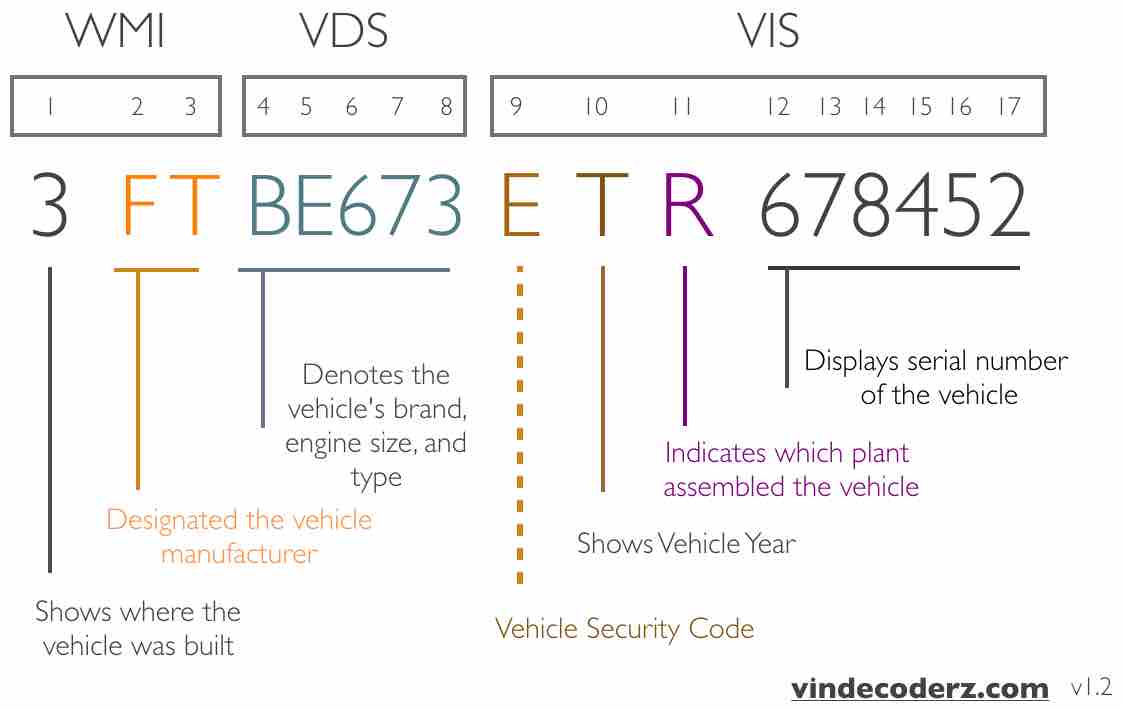VIN Decoder & Lookup
Acura Airstream Alfa Romeo Aprilia Arctic Cat Aston Martin Audi Alpina BAW Bentley Brilliance BMW Buick Bugatti BYD Cadillac Caterpillar Can-Am Chery Chevrolet Chrysler Citroen Coachmen Dacia Daewoo DAF Daihatsu Daimler Dodge Ducati Ferrari Fiat Ford Fleetwood Gaz GMC Geely Genesis Great Wall Harley Davidson Hafei Haima Honda Holden Hummer Husqvarna Hyundai Infiniti International Isuzu Iveco Jaguar Jayco Jeep Kenworth Keystone Kia KTM Lada Lamborghini Lancia Land Rover Lotus Lexus Lifan Lincoln Lucid Mack Mahindra Maruti MAN Maserati Mercury McLaren Mazda Mercedes-Benz MG Mini Mitsubishi Navistar Nissan Opel Oldsmobile Peterbilt Plymouth Peugeot Pontiac Porsche RAM Renault Rolls-Royce Rover Saturn Saab Scion Scania Seat Skoda Smart SsangYong Subaru Suzuki Tata Tesla Triumph Vauxhall Toyota Volvo Winnebago Yamaha Freightliner Kawasaki Volkswagen
What is structure of Vehicle Identification Number?
The diagram below illustrates the standard structure of a Vehicle Identification Number (VIN). It serves as a reference format used by modern VIN decoder systems.
Please note that vehicles manufactured prior to 1981 may have shorter VINs, as they were not yet subject to the ISO 3779 standard, which mandates a 17-character format. Today’s VINs are globally standardized to ensure consistency and provide detailed information about each vehicle’s origin, specifications, and history.
VIN Decoder:

VIN Decoder Services: Unlocking the DNA of Every Vehicle
A Vehicle Identification Number (VIN) is far more than a random series of 17 letters and numbers stamped onto a car — it’s the DNA of the vehicle. Every VIN holds detailed information about a car’s origin, make, model, and much more. To the untrained eye, it may look like a string of gibberish, but with the right tools, that code reveals everything from the year of manufacture to accident history.
That’s where a VIN Decoder Service comes in — acting as a Rosetta Stone for vehicles, it translates that complex identifier into meaningful insights for buyers, sellers, and regulators alike.
What Is a VIN?
A VIN is a unique code assigned to every vehicle when it’s manufactured. It functions as the vehicle’s fingerprint — no two vehicles share the same VIN. You’ll typically find it:
On the dashboard, visible through the windshield
Inside the driver-side door jamb
On key documents like the title, registration, and insurance policy
This standardized 17-character code contains a wealth of information if you know how to decode it.
The Anatomy of a VIN
Although it appears random, each character in a VIN has a specific purpose:
1st character: Country of origin
2nd–3rd characters: Manufacturer
4th–8th characters: Vehicle features (body style, engine type, model)
9th character: Check digit (used to detect invalid VINs)
10th character: Model year
11th character: Manufacturing plant
12th–17th characters: Vehicle’s unique serial number
Because of this complexity, manual decoding is error-prone — which is why VIN decoder services are essential.
How Does a VIN Decoder Work?
A VIN Decoder takes the 17-character VIN and breaks it into easily understandable data. These services are connected to vast automotive databases and return detailed information such as:
Make and model
Year of manufacture
Engine specifications
Country and factory of origin
Known recalls or service bulletins
Reported accidents
Ownership history
And much more
Why Are VIN Decoder Services Important?
✅ For Consumers
When buying a used car, a VIN decoder helps ensure you’re not purchasing a vehicle with hidden issues like flood damage, odometer fraud, or a salvage title. It gives buyers confidence and clarity before making a major investment.
✅ For Dealerships and Resellers
Dealerships use VIN decoders to:
Accurately evaluate trade-ins and auction purchases
Verify inventory details
Provide transparent, trustworthy information to customers
This transparency builds credibility and supports better customer relationships.
✅ For Regulatory Bodies
Law enforcement and transport authorities rely on VIN decoding to:
Track stolen vehicles
Verify vehicle authenticity
Enforce compliance and safety standards
In this context, a VIN decoder isn’t just a convenience — it’s a compliance tool.

